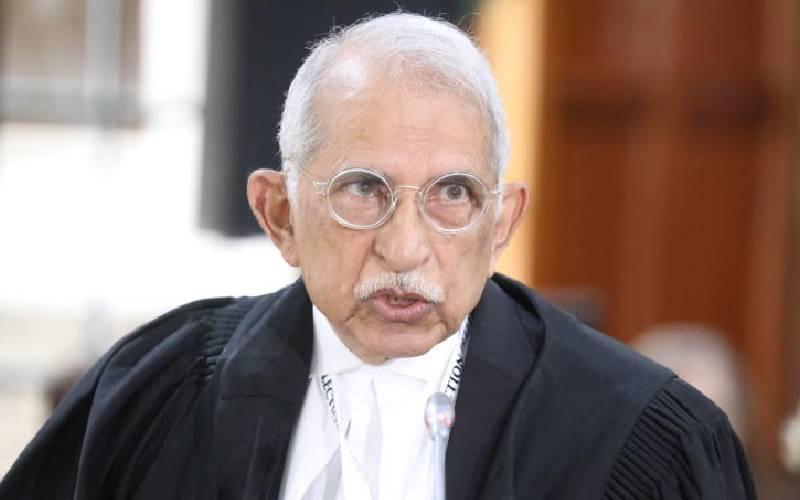
A film which merits our careful attention has been screening in Nairobi. It is titled ‘Threads that Tie Us: An Oshwal Odyssey”. It is about the Oshwal community, known to us more familiarly as the Shah community.
It has been written, directed and produced by Ms Bindu Shah. The multi-talented Bindu Shah is an accomplished classical dancer, choreographer, teacher of the arts, and a huge creative force. This is a polished production, technically at the highest level.
In search of information, viewpoints and interviewees, the camera travels to Kenya, India, Britain and Canada, where Ms Bindu Shah now resides. The Jains originated in Orissa in eastern India. Jainism was founded in Bihar in the 5th Century BC E by Mahavir, the last Tirthanker (‘guide’).
“After Mahavir’s death there was a 12-year famine in Bihar, where there was a sizeable Jain community. One leader led his followers westwards, until they arrived at a town called Oshia [in Rajasthan]. There they stopped for a while. When they moved on again, passing through Rajasthan and into Gujarat, they were known as people from Oshia – the Oshwals. They settled next in Cutch, and then some moved southwards into Kathiawar, where they spread out among some fifty villages around Jamnagar. This district is called Halar, and these Oshwals are known as the Halari Visa Oshwals. (‘Visa’ simply means ‘section’).
About 70 per cent of Kenya’s Jains are Halari Visa Oshwals.” (Through Open Doors by Cynthia Salvadori) “The Jains are also often collectively referred to as ‘the Shahs’, since Shah is a very common clan surname among them. It is said to come from the title ‘shah’ bestowed upon some Jains by Sultan Sher Shah [of Delhi].” (Ibid).
“The name Jain is derived from the word ‘jina’ meaning ‘conqueror’ (of worldly desire), so a Jain is a follower of the ‘jina’ (Ibid). The central principles of Jainism are ‘ahimsa’ (non-injury) and ‘anekantrad’ (tolerance) with four other virtues.
In the history of the Hilari Jains in Kenya much is repeated about how this or that elder is the first Jain to have come to Kenya, whether in 1916 and 1919 or even 1898. The earliest recorded Jain presence in Kenya is however over five hundred years earlier!
This is what Vasco da Gama’s historian Joao de Barros writes of the landing at Malindi (during the first voyage of 1498) in his ‘Decadas de Asia’: “[Vasco da Gama] received also the visit of some Moors [Indians] from the Kingdom of Cambaye [now Bharuch], who were passing through Malindi on board their ships. Among them were some men called banians of this Kingdom of Cambaye, men so religious that they do not even kill the vermin on their bodies.” These were of course Jains. The camera at Malindi, (the waterfront has not altered at all), and this history voiced over would have enriched the film further. The film touches on origins, oral history, and day-to-day living. A major focus of the film is the issue of identity. But the community’s youth also deserve to see some non-fiscal ambitions of the community.
Thus, the literary achievements of members would have helped them. I particularly missed seeing the work of the Oshwals’ most prominent artist, Kamal Shah, one of Kenya’s leading painters. He has exhibited internationally; him speaking on his paintings would be welcome.
The film directs its content mainly to an inward-looking audience, the community itself. But it is important that the film be enlarged to speak to fellow citizens around the young Jains. This is because young Jains, wherever they reside, are growing up now in pluralist societies. They should thus also know about the community’s part in the history of their country and not just the history of the Hilari in a vacuum.
Not many of us know the extremely important part that the Oshwal community played in preserving Kenya at a critical moment in our history in the 1980s. All Kenya is grateful.
The film is touching in the deeply felt desire of Bindu Shah to pass on to her children a rational attachment to the faith and its noble ideals. What Cynthia Salvadori reminded us, can help.
She said, “Jainism is essentially an ethical doctrine, not a religious dogma; Jains worship virtues, not gods – and that these virtues are as relevant today as they were more than two thousand years ago.” (Ibid)
The writer is senior counsel
Stay informed. Subscribe to our newsletter
 The Standard Group Plc is a
multi-media organization with investments in media platforms spanning newspaper
print operations, television, radio broadcasting, digital and online services. The
Standard Group is recognized as a leading multi-media house in Kenya with a key
influence in matters of national and international interest.
The Standard Group Plc is a
multi-media organization with investments in media platforms spanning newspaper
print operations, television, radio broadcasting, digital and online services. The
Standard Group is recognized as a leading multi-media house in Kenya with a key
influence in matters of national and international interest.
 The Standard Group Plc is a
multi-media organization with investments in media platforms spanning newspaper
print operations, television, radio broadcasting, digital and online services. The
Standard Group is recognized as a leading multi-media house in Kenya with a key
influence in matters of national and international interest.
The Standard Group Plc is a
multi-media organization with investments in media platforms spanning newspaper
print operations, television, radio broadcasting, digital and online services. The
Standard Group is recognized as a leading multi-media house in Kenya with a key
influence in matters of national and international interest.






